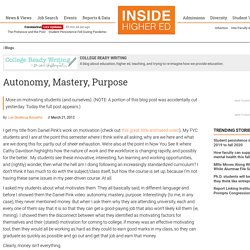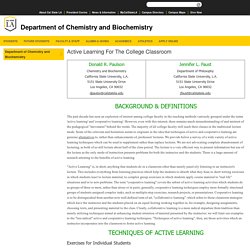

10 ways to differentiate learning. Once upon a time in the olden days, the teacher stood out front and taught the whole class the same material in the same way.

Everyone was expected to do the same tasks, some passed and some failed and were labelled ever after. The focus was on teaching, not on learning. One size was supposed to fit all and if you learned in a different way, too bad for you. Time passed and it turned out that everyone didn’t learn in the same way after all. The teacher realised that learners have different needs, interests and abilities. She needed to think about differentiation in a different way. 10 ways to differentiate learning… 1. Give the students (at least some) ownership of their learning. 2. One size does not fit all. 3. Learners don’t need total mastery of all the skills before they can apply them. 4. Beyond Student Engagement: Achieving a State of Flow.
Think about a time when you were really engaged in something, the kind of engagement where you lose track of time and experience feelings of joy and satisfaction.

You may have felt acutely focused, physically, mentally, and emotionally absorbed in a task. I've felt this most often while writing, reading, teaching, and coaching -- always signaled by the moment when I notice the clock and, feeling dazed, wonder where the hours have gone. The feelings are pleasant and there are always outcomes, a chapter written, or a complicated dilemma unraveled, for example. It wasn't until I heard about the work of the Hungarian psychologist, Mihaly Csikszentmihalyi, that I learned that this notion has a name: Flow.
I would like to urge the education community to move beyond a discussion of "engagement," with its vague definitions and murky attributes, to a conversation on flow; I'd like to propose that our task as educators is to increase the experiences of flow for students. What is Flow? Anna smith: NYU #literacies:Check out... Videos to help you rethink education, learning, & school. Having children causes one to (re)think seriously about education and the role of school.

Education obviously is the most powerful thing in the world. And yet the old Mark Twain chestnut — "I never let school get in the way of my education" — speaks to the core of my own thinking regarding education. I am not an expert in education by any means, but like almost everyone, I have strong ideas based on my personal experiences going through formal, mass schooling. Personally, the best years where I learned the most and was inspired to study and learn on my own were surely the six years of elementary school, and then university and graduate school.
One thing I am sure of is that while listening carefully to teachers (and to the masters, etc.) is important, the real learning requires lots and lots of doing, not just listening. Seth Godin on EducationIn this short interview, Seth Godin sums up the essence of the problem. Dr. Presentation tips for teachers (Never give a boring lecture again!) Autonomy, Mastery, Purpose.
I get my title from Daniel Pink’s work on motivation (check out this great little animated video).

My FYC students and I are at the point this semester where I think we’re all asking, why are we here and what are we doing this for, partly out of sheer exhaustion. We’re also at the point in Now You See It where Cathy Davidson highlights how the nature of work and the workforce is changing rapidly, and possibly for the better. My students see these innovative, interesting, fun learning and working opportunities, and (rightly) wonder, then what the hell am I doing following an increasingly standardized curriculum?
I don’t think it has much to do with the subject/class itself, but how the course is set up, because I’m not having these same issues in my peer-driven course. At all. I asked my students about what motivates them. Clearly, money isn’t everything. Bill Gates tweeted something the other day that really made me angry. And it isn’t working. Visions of Students Today. Teaching strategies for the college classroom. Active Learning For The College Classroom. The past decade has seen an explosion of interest among college faculty in the teaching methods variously grouped under the terms 'active learning' and 'cooperative learning'.

However, even with this interest, there remains much misunderstanding of and mistrust of the pedagogical "movement" behind the words. The majority of all college faculty still teach their classes in the traditional lecture mode. Some of the criticism and hesitation seems to originate in the idea that techniques of active and cooperative learning are genuine alternatives to, rather than enhancements of, professors' lectures. We provide below a survey of a wide variety of active learning techniques which can be used to supplement rather than replace lectures.
We are not advocating complete abandonment of lecturing, as both of us still lecture about half of the class period. "Active Learning" is, in short, anything that students do in a classroom other than merely passively listening to an instructor's lecture.